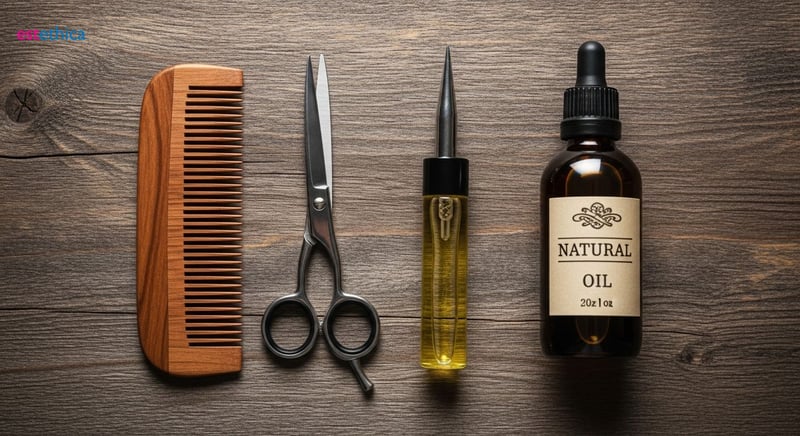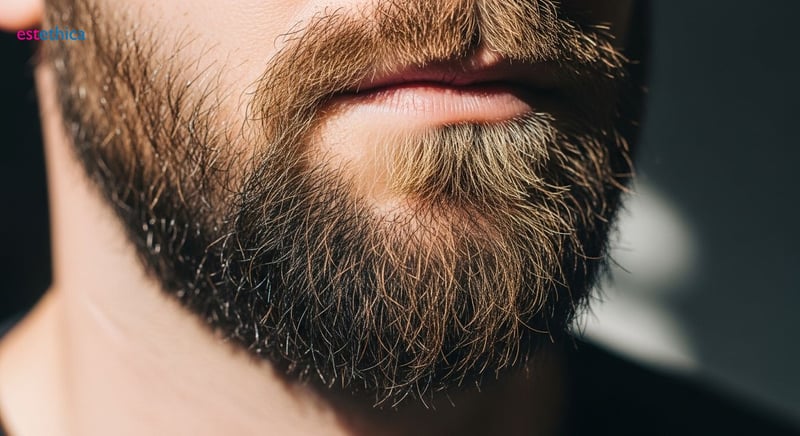Beard Implants: Crafting the Perfect Facial Hair
Discover how beard implants can craft your perfect facial hair with our in-depth guide, covering techniques, recovery, and more.
In today's grooming world, having a well-defined beard is a mark of style and confidence. However, not everyone is naturally endowed with the perfect beard. This is where beard implants come into the picture, offering a solution for those seeking fuller facial hair. This blog explores the various aspects of beard implants, helping you understand the procedure and what to expect.
Understanding Facial Hair Restoration: Is It Right for You?
Exploring the Benefits of Facial Hair Restoration
Facial hair restoration through beard transplant offers numerous advantages for men seeking to enhance their appearance. This procedure can fill in patchy areas, create a more defined jawline, and boost self-confidence. Ideal candidates often have specific aesthetic goals. A recent study indicated that 87% of men who underwent beard implants reported increased satisfaction with their facial appearance. For instance, individuals with scars or burns can regain a natural look through carefully placed grafts. Those with genetic predispositions for thin facial hair can achieve the beard density they desire.
Key advantages of Beard Implants
- Achieving a fuller, more symmetrical beard that complements facial features.
- Camouflaging scars from accidents or previous surgeries with strategically placed hair follicles.
- Correcting congenital conditions that affect hair growth on the face.
Consulting with a qualified specialist at estethica Global is essential to determine the most suitable approach and manage expectations. Proper evaluation ensures that the final result aligns with individual preferences and facial structure.
Understanding the Factors Influencing Beard Density
Several factors can affect beard density, including genetics, hormones, and lifestyle. Understanding these elements helps determine if facial hair restoration is a viable option. Genetic predispositions often play a significant role, with some men naturally having thicker beards. Hormonal imbalances, such as low testosterone, can also impact hair growth. Statistically, approximately 40% of men experience noticeable thinning of facial hair by age 30. Simple lifestyle choices, like maintaining a balanced diet and reducing stress, can positively influence hair health. For example, a diet rich in protein and vitamins supports healthy follicle function. Addressing underlying health conditions and consulting with experts at estethica Global provide personalized insights to achieve optimal beard density through targeted treatments.
Steps to Improve Beard Density
- Consult a specialist to assess hormonal levels and overall health factors.
- Incorporate a balanced diet rich in vitamins and proteins to nourish hair follicles.
- Consider beard implants if other methods prove insufficient.
Beard transplants can be particularly effective if other methods fail to produce the desired thickness. A well-executed beard transplant before and after shows a considerably denser and more uniform beard.

Beard Transplant Techniques: FUE vs. FUT - What's the Difference?
Comparing FUE and FUT for Beard Implants
When exploring beard implants, Follicular Unit Extraction (FUE) and Follicular Unit Transplantation (FUT) stand out as primary techniques. FUE involves extracting individual follicles directly from the donor area, typically the back of the scalp, using small punches. This method minimizes scarring, leaving tiny, almost invisible marks. FUT, conversely, involves removing a strip of skin from the donor area, from which the follicles are then dissected. FUT allows for harvesting a larger number of grafts in a single session but results in a linear scar. Choosing between FUE and FUT often depends on factors such as the size of the area needing coverage and the patient's tolerance for scarring. estethica Global specialists can provide a detailed assessment to determine the most suitable approach.
Key Differences Between FUE and FUT
- FUE offers minimal scarring with quicker recovery times.
- FUT allows for transplanting a larger number of follicles in one session.
- FUE is ideal for smaller areas, while FUT is suitable for extensive facial hair restoration.
Ideal Candidates for FUE vs. FUT Beard Transplant
The choice between FUE and FUT for a beard transplant depends on individual characteristics and desired outcomes. FUE is often recommended for patients who prefer to wear their hair short, as it leaves virtually undetectable scars. It's also suitable for those who require a smaller number of grafts to fill in patchy areas. FUT may be more appropriate for individuals needing significant beard density, as it allows for a higher yield of follicles. For instance, someone seeking to create a full, dense beard might benefit more from FUT. Meanwhile, a person only wanting to fill in a few bare spots might find FUE sufficient. estethica Global specialists consider factors like hair type, skin elasticity, and overall health to recommend the best technique. A personalized approach ensures optimal results that align with each patient's unique needs.
Factors Influencing Technique Selection
- Extent of hair loss or patchiness in the beard area.
- Patient's preference regarding scarring and recovery time.
- Availability of donor hair and its suitability for transplantation.

Achieving Natural-Looking Results: Factors Influencing Beard Density
Optimizing Beard Density Through Planning
Achieving a natural-looking beard post-transplant hinges on meticulous planning and execution. The surgeon's skill in placing grafts to mimic natural hair growth patterns is paramount. Utilizing technologies like 3D imaging allows for precise mapping of the beard area to ensure optimal density and symmetry. The density of the donor hair also plays a crucial role, as a limited supply can impact the overall achievable fullness. For instance, a surgeon might use a higher density of grafts along the jawline to create definition, while using a slightly lower density in the cheek area for a more natural gradient. Proper planning ensures that the final result not only meets but exceeds expectations, providing a seamless and undetectable enhancement. estethica Global emphasizes a personalized approach, tailoring each transplant to the individual's unique facial structure and hair characteristics, ensuring a result that looks both natural and aesthetically pleasing.
Key Factors for Optimal Beard Density
- Detailed pre-operative planning with 3D imaging to map hair placement.
- Strategic graft placement to mimic natural hair growth patterns and density variations.
- Careful consideration of donor hair density to manage expectations and optimize results.
Post-Operative Care and Long-Term Beard Health
Post-operative care is essential for ensuring the transplanted facial hair looks natural and remains healthy. Keeping the transplanted area clean and free from infection is crucial in the days and weeks following the procedure. Specific lifestyle recommendations, such as avoiding strenuous activities and direct sun exposure, can significantly impact the survival rate of the grafts. For example, gentle washing with a mild cleanser and applying prescribed ointments help prevent complications. Furthermore, following a nutrient-rich diet and staying hydrated supports overall hair health, promoting stronger and more vibrant growth. Studies show that patients who adhere closely to post-op guidelines experience a higher success rate and more satisfying outcomes. estethica Global provides comprehensive aftercare instructions and ongoing support to ensure that your new facial hair thrives, maintaining its natural appearance and feel for years to come. Our commitment extends beyond the procedure, focusing on long-term health and satisfaction.
Essential Steps for Post-Transplant Care
- Regularly clean the transplanted area with a mild cleanser to prevent infection.
- Adhere to lifestyle recommendations, such as avoiding strenuous activities and sun exposure.
- Maintain a nutrient-rich diet and stay hydrated to support hair follicle health and growth.

The Complete Guide to Beard Implants Recovery and Aftercare
Navigating the Initial Days After Your Beard Implants
The initial recovery phase following a beard transplant is crucial for optimal results and minimizing complications. Patients are typically advised to take it easy for the first few days, avoiding strenuous activities that could disrupt the newly implanted follicles. Adhering to a gentle skincare routine is also important. For instance, harsh cleansers should be avoided in favor of milder, hypoallergenic options. Proper hydration supports the healing process from within. Gentle washing with lukewarm water and applying any prescribed ointments helps keep the area clean and prevents infection. estethica Global provides detailed aftercare instructions to guide patients through this critical period, ensuring the best possible outcome for their facial hair restoration journey.
Dos and Don'ts for Initial Recovery
- Do use a gentle, hypoallergenic cleanser to keep the transplanted area clean.
- Do avoid direct sun exposure by wearing a hat or using sunscreen recommended by your doctor.
- Don't engage in strenuous activities that could cause sweating or physical trauma to the face.
Long-Term Aftercare for Sustained Beard Density
Long-term aftercare is vital to ensuring the longevity and health of your transplanted beard. Regular moisturizing is essential, as the skin around the beard can become dry. Using a beard oil or balm helps maintain hydration and keeps the hair soft and manageable. Trimming the beard regularly maintains its shape and encourages healthy growth, and helps maintain beard density. A balanced diet rich in vitamins and minerals supports ongoing follicle health. Avoiding harsh chemicals and excessive heat from styling tools prevents damage to the transplanted hair. estethica Global provides comprehensive guidance on long-term care, empowering patients to maintain a healthy, natural-looking beard for years to come. Consistent and diligent aftercare ensures the initial investment in beard implants continues to deliver aesthetic benefits.
Key Practices for Long-Term Beard Health
- Moisturize regularly with beard oil or balm to maintain hydration and softness.
- Trim the beard periodically to maintain its shape and encourage healthy growth.
- Maintain a balanced diet rich in vitamins and minerals to support follicle health.
Transform Your Look: The Ultimate Beard Transplant Guide
Precision Graft Placement for Natural-Looking Beard Transplants Using 3D Imaging
estethica excels in performing beard transplants using advanced techniques such as Follicular Unit Extraction (FUE) and Follicular Unit Transplantation (FUT). These methods allow for precise extraction and placement of hair follicles, ensuring a natural and aesthetically pleasing result. The use of 3D imaging technologies enables detailed mapping of the beard area for optimal density and symmetry.
estethica's specialists possess extensive experience in facial hair restoration, offering personalized consultations to determine the most suitable approach for each patient. Their expertise ensures that transplanted hair mimics natural growth patterns and complements individual facial structures. Continuous training and adoption of innovative techniques allow estethica to remain at the forefront of beard transplant procedures.
Comprehensive Post-Operative Care Improving Long-Term Health of Transplanted Facial Hair
estethica prioritizes patient safety and health, providing detailed aftercare instructions and ongoing support to optimize the success of beard implants. Recommended guidelines include gentle cleansing, avoiding strenuous activities, and following a nutrient-rich diet to ensure the transplanted hair thrives. Long-term strategies are designed to maintain beard density and overall hair health.
Patients at estethica benefit from thorough pre-operative planning and meticulous post-operative care, contributing to healthier, natural-looking beards. The clinic’s commitment to excellence ensures consistent, satisfying outcomes and long-term aesthetic improvements through facial hair restoration.
Frequently Asked Questions
What are beard implants and who is a good candidate for facial hair restoration?
What's the difference between FUE and FUT techniques for a beard transplant?
How can I ensure natural-looking results from my beard implants regarding beard density?
What does the recovery and aftercare entail after getting beard implants?
Achieve your aesthetic goals with estethica's expert consultations and personalized treatment plans.
📞 Claim Your Free Consultation!